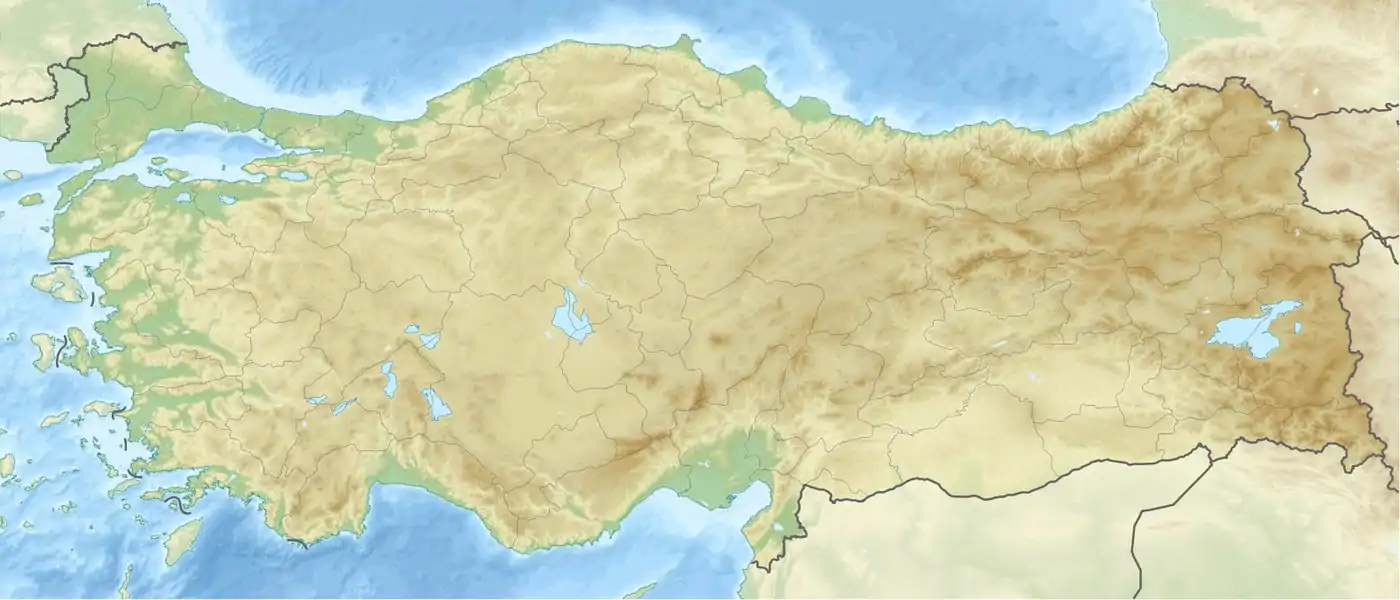Nur Mountains
The Nur Mountains (Turkish: Nur Dağları, "Mountains of Holy Light"), formerly known as Alma-Dağ,[1] the ancient Amanus (Ancient Greek: Ἁμανός), medieval Black Mountain or Arabic Jabal al-Lukkam,[2] is a mountain range in the Hatay Province of south-central Turkey, which starts south of the Taurus Mountains (and is linked with it), south of the Ceyhan river (old name: Pyramus), runs roughly parallel to the Gulf of İskenderun (old name: Gulf of Issus) (İskenderun was called Alexandria of Cilicia) and ends in the Mediterranean coast between the Gulf of İskenderun and the Orontes (Asi) river mouth.
| Nur Mountains | |
|---|---|
| Alma-Dağ | |
 Nur Mountains | |
| Highest point | |
| Elevation | Bozdağ Dağı |
| Naming | |
| Native name | Nur Dağları (Turkish) |
| Geography | |
| Country | Turkey |
| Province | Hatay |


The range has about 100 miles (200 kilometers) in length and reaches a maximum elevation of 2,240 m (7,350 ft) and divides the coastal region of Cilicia from Antioch and inland Syria making a natural border between Asia Minor (Anatolia), in the southeast region, and the rest of Southwest Asia. The highest peak is Bozdağ Dağı. A major pass through the mountains known as the Belen Pass (Syrian Gates) is located near the town of Belen. Another pass known as the Amanic Gates (Bahçe Pass) lies farther north.
The specific term "Mount Amanus" is referred to by ancient writers.[3][4] In the Middle Ages, it was called the Black Mountain in Byzantine Greek, Armenian, Syriac and Latin. There were numerous Armenian, Melkite, Jacobite, Georgian, and Catholic monasteries and hermits in the mountains. On account of this, it was called Gâvur Dağ (Mount of Infidels) by the Turks. In 1028, the Emperor Romanos III, disturbed by the number of "heretical" (i.e., Syriac and Armenian) monks in the Black Mountain, tried to draft them for his campaign against Aleppo. In 1066, the monasteries were devastated by Afshin Bey. In 1098, the monks gave provisions to the Crusader army besieging Antioch.[5]
See also
References
- Merriam-Webster's Geographical Dictionary, Third Edition. Springfield, MA: Merriam-Webster. 1997. p. 855. Retrieved 19 January 2017.
- Mohsen Zakeri, Sasanid Soldiers in Early Muslim Society: The Origins of 'Ayyārān and Futuwwa (Otto Harrassowitz Verlag, 1995), p. 151.
- Grote, George (1862). A History of Greece. London: John Murray. p. 312. Retrieved 19 January 2017.
Mount Amanus.
- Anthon, Charles (1872). A Classical Dictionary. New York: Harper & Brothers. Retrieved 19 January 2017.
- Jos J. S. Weitenberg, "The Armenian Monasteries in the Black Mountain", in K. Ciggaar and M. Metcalf (eds.), East and West in the Medieval Eastern Mediterranean, Vol. 1 (Peeters, 2006), pp. 79–81.